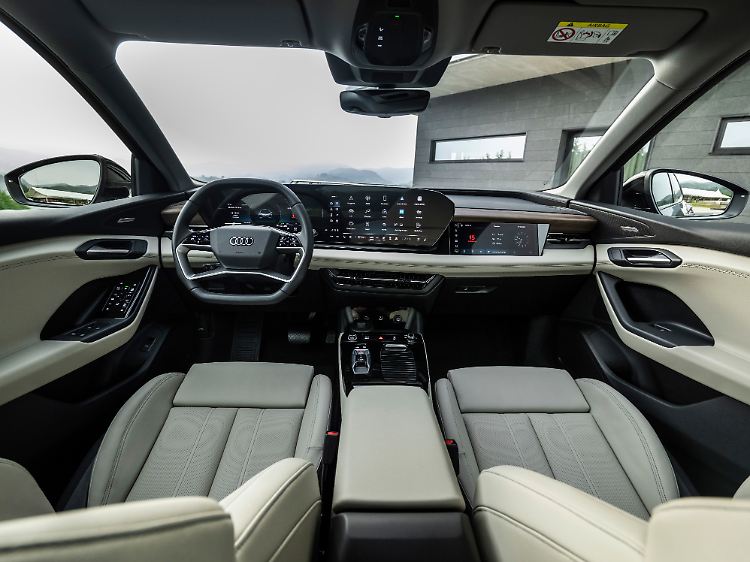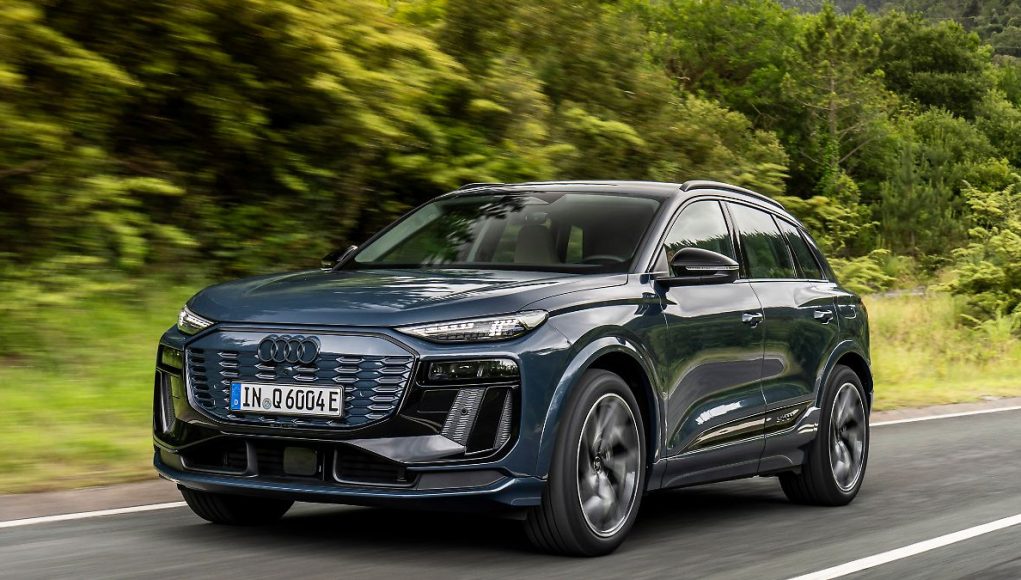The Q6 eTron is intended to sharpen Audi's model range and take Germany a step further in electromobility. ntv.de drove the electric car that the Ingolstadt-based company is eagerly awaiting.
Audi has already made a good start in electromobility. The Ingolstadt-based company was early with the SUV E-Tron, as well as with the sports sedan E-Tron GT, which is known for being a pretty fast charger. And then there is the more affordable Q4 E-Tron based on the modular electric kit – with rather poor charging performance. So all that is needed is a balanced middle ground. And ideally one with decent charging performance.


From the front, the Audi looks modern thanks to its sleek headlights. But the bottom line is that the design was only approached with caution.
(Photo: Audi)
This task now falls to the Q6 E-Tron. This model is eagerly awaited, especially since it was supposed to be presented in 2022 – electronics problems are rumored to be the reason for the delay. Well, now the mid-range model is finally here. And anyone who takes a look at the newcomer will probably start to think. Especially if they have previously examined the futuristic Concept Vision New Class X from BMW.
Conservative stylistics


The rear section of the Audi Q6 in particular looks quite conservative. But it's funny that you can change the light graphics of the OLED taillights in the menu.
(Photo: Audi)
On the other hand, you really have to look for the novelty value of the conservatively designed Q6. Digital OLED taillights with light designs that can be changed in the menu are of little help, even though this gimmick is somehow charming.
On the other hand: Perhaps the Upper Bavarian's styling isn't such a bad choice after all. After all, the Q6 isn't necessarily intended for young hipsters, but rather for established middle-aged people with a good job and a sense for solid design without frills.
Modern inside


The completely new infotainment display looks architecturally fine. And there is now also a display for the front passenger.
(Photo: Audi)
Inside, however, the architects have already given the new Audi a clearly visible makeover. A wide screen with elegant curves (plus a display for the passenger on request) replaces the instruments that are otherwise somewhat stuffy in Audi. Here, the operator can experience a well-stocked menu, which will take some time to master. But so far, that's fine. Fortunately, there is a physical button for the assistant menu in the center console, so the driver doesn't have to search for long to limit the amount of driving autonomy.
Now, of course, the Q6 wants to be tried out. However, Audi is refraining from bringing the basic version (306 hp and rear-wheel drive). And even that currently costs a hefty 68,800 euros to start with. At least one can hope that in the future there will be versions with a smaller battery for customers who do not need 100 kWh of battery capacity. And power storage is ultimately what drives up prices.


The Audi Q6 can certainly handle light gravel roads.
(Photo: Audi)
And so the first test drive begins with the 388 hp Quattro model. It was basically clear beforehand that there would be no lack of power based on the driving impression. So the all-wheel drive vehicle marches forward emphatically. But its striking skills actually lie elsewhere. Firstly, the specifications seem to have stated that the 4.77 meter long SUV should be particularly quiet, which was definitely implemented. And secondly, those Audi experts who expected to get a firm chassis will be surprised. In this case, the air-sprung chassis (extra charge) is not firm at all, which makes the Q6 a recommendation for comfort lovers. To match this, there are ergonomically beautifully shaped seats with all kinds of technical stuff, including an effective massage function.
Of course, the Ingolstadt-based company hasn't missed the opportunity to up the performance an notch with the SQ6. And not only does the power increase from 388 to 517 hp. The price also climbs, from 74,700 to an official 93,800 euros. This means that the 4×4, which is rather compact by mid-range standards these days, even trumps its big brother, the SQ8 E-Tron, in terms of performance. The only difference is that the 2.4-ton six-seater is around 300 kilograms lighter. It storms off with corresponding power, reaching 100 km/h in 4.3 seconds. This means that the S even beats the basic all-wheel drive Q6 by 1.6 seconds in this sprint. And the top speed here is 230 instead of 210 km/h.
The PPE-Audi focuses on efficiency


Thanks to 800 volts, the Audi Q6 shouldn't have to stay at the charging station for long. Even at over 50 percent charge, the charging power should still be more than 200 kilowatts. But that still needs to be tested.
(Photo: Audi)
And despite the wiry values, Audi is pursuing a different goal with its PPE project (Premium Platform Electric) than, for example, Porsche with the Macan, which also uses this architecture. Even in the sporty version, the Ingolstadt-based car is smoother, although not at all pressure-free. The engine configuration shows that efficiency plays a major role here: an asynchronous electric motor works at the front. If you reduce the load on this, it can be dragged along without generating any significant braking torque. In contrast, a more efficient permanent magnet synchronous machine works at the rear. Porsche, on the other hand, does without the asynchronous motor and remains performance-oriented throughout.
Anyone who drives a Q6 will get by with relatively little electricity, at least according to Audi's promise. The range is between 17 and 19.6 kWh per 100 kilometers in the average WLTP discipline. This means the range is up to 625 kilometers.
But apart from the pending test of how long the power really lasts, it would also be interesting to know how quickly it is fed back into the battery. And yes, Audi is using a system with an 800-volt electrical system for the first time in the mid-range segment. Regardless of the version, there is a high charging capacity of 260 or 270 kW for the all-wheel drive models. This means that it should only take around 20 minutes to charge the battery from 10 to 80 percent. And this could make the Audi interesting for long-distance use for the first time. In this sense, the Q6 would make a contribution to electromobility as a whole. Whether enough potential buyers will accept this offer is another matter.
































